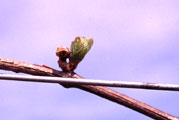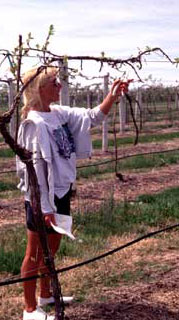Spring Frost Injury
Spring frost injury is another type of cold injury. After the vine has remained dormant throughout its rest period, warm weather in late February or March will cause the plant to begin developing. The more developed a bud or shoot becomes, the less hardy it is. Cultivar identity determines both the rate of shoot development as well as the actual hardiness at any given stage. Spring frost injury is the most common form of injury suffered by the more winter hardy cultivars. Leon Millot, for example, is quite winter hardy, but breaks bud early, thus creating a spring frost hazard.
Prevention of spring frost injury primarily rests in site selection, that is, choosing a site that allows cold air to drain away from it. If a low area must be planted, it should be occupied by cultivars that are hardier and break bud later in the season. Note that cold air settles at the tips of a continuous cover crop or ground cover; therefore, a very high cover will hold cold air nearer to the canes and buds. Delayed pruning or double pruning will also help minimize the hazard. Leaving canes or spurs that are longer than necessary not only aids in pruning adjustment for winter injury, but also causes buds closest to the old wood to break later. The apical or end buds develop first and suppress the development of the buds nearer the trunk or arm. The less developed a bud, the hardier it is, so the more developed end buds can be removed after the threat of spring frost injury has diminished. Mechanical, physical, and chemical methods of frost protection have not been demonstrated to be economically feasible as yet and there are no current recommendations on this.

Spring growth of a secondary bud after the primary bud was killed by cold spring temperatures.spring growth of a secondary bud after the primary bud was killed by cold spring temperatures.

Final bud adjustment after growth starts in spring.Final bud adjustment after growth starts in spring.